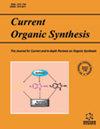开发使用肼酰卤合成新噻二唑的合适方法
IF 2.5
4区 化学
Q3 CHEMISTRY, ORGANIC
引用次数: 0
摘要
背景:肼酰卤和二硫代碳酸甲肼通常被用于合成杂环化合物。方法:本研究介绍了一种新的简单方法,即在碱性介质存在下,通过 N-(萘-1-基)-2-氧代丙烷肼酰氯或 2-氯-2-(2-(萘-1-基)肼基)乙酸乙酯与二硫代甲肼反应,在回流条件下制备新的噻二唑。本研究设计了合成方案来展示化学反应。使用元素分析、傅立叶变换红外光谱法(FT-IR)、质谱法(MS)和核磁共振法(NMR)对最终化合物进行鉴定和表征。结果:合成最终的噻二唑分子有两种方法。第一种方法是将肼二硫代碳酸甲酯的硫醇酯与肼酰基的氯化碳进行亲核取代。然后移除盐酸,得到 S-烷基化的中间体。通过分子内原位环缩合过程,甲硫醇从该中间体中消除,得到最终产物。在随后的[3+2]环加成反应中,硝基亚胺与 C=S 发生 1,3-二极环加成反应,然后甲硫醇被重新移除。结论:该方法利用价格低廉、易于获得的试剂和简单的反应条件,制备出产率令人满意的新噻二唑衍生物。本文章由计算机程序翻译,如有差异,请以英文原文为准。
Development of a Suitable Method for the Synthesis of New Thiadiazoles Using Hydrazonoyl Halides
Background: Hydrazonoyl halides and methylhydrazinecarbodithioate have been generally utilized in the synthesis of heterocycles. Methods: This study describes a new and simple method to prepare new thiadiazoles from the reaction of N-(naphthalen-1-yl)-2-oxopropanehydrazonoyl chloride or ethyl 2-chloro-2-(2-(naphthalen-1-yl)hydrazono)acetate with methylhydrazinecarbodithioate in the presence of basic medium under reflux. In this study, the synthetic schemes are designed to show the chemical reactions. Elements analysis, Fourier Transform Infrared Spectroscopy (FT-IR), Mass Spectrom-etry (MS), and Nuclear Magnetic Resonance (NMR) are used to identify and characterize the final compounds. Results: There are two ways to synthesize the final thiadiazoles molecules. The first can be through nucleophile substitution of thiolate of methylhydrazonecarbodithioate to the chlorinated carbon of hydrazonoyl. Hydrochloric acid is then removed to provide an S-alkylated intermediate. Methanethiol is eliminated from this intermediate by an in situ intra-molecular cyclocondensation process to give the final products. The subsequent [3+2] cy-cloaddition involving 1,3-dipolar cycloadditions of nitrilimines to C=S is succeeded by the re-moval of methanethiol. Conclusion: This approach utilizes affordable, readily accessible reagents and simple reaction conditions to produce new thiadiazole derivatives with satisfactory yields.
求助全文
通过发布文献求助,成功后即可免费获取论文全文。
去求助
来源期刊

Current organic synthesis
化学-有机化学
CiteScore
3.40
自引率
5.60%
发文量
86
审稿时长
6-12 weeks
期刊介绍:
Current Organic Synthesis publishes in-depth reviews, original research articles and letter/short communications on all areas of synthetic organic chemistry i.e. asymmetric synthesis, organometallic chemistry, novel synthetic approaches to complex organic molecules, carbohydrates, polymers, protein chemistry, DNA chemistry, supramolecular chemistry, molecular recognition and new synthetic methods in organic chemistry. The frontier reviews provide the current state of knowledge in these fields and are written by experts who are internationally known for their eminent research contributions. The journal is essential reading to all synthetic organic chemists. Current Organic Synthesis should prove to be of great interest to synthetic chemists in academia and industry who wish to keep abreast with recent developments in key fields of organic synthesis.
 求助内容:
求助内容: 应助结果提醒方式:
应助结果提醒方式:


